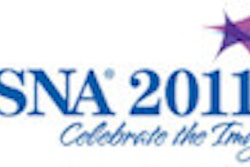
An automated PACS alert mechanism for communicating unexpected findings on chest x-rays can lead to improvements in clinicians' response times, and provide detailed information on patient outcome, according to an Irish study presented at last week's RSNA congress.
The failure to act on imaging reports represents a significant threat to patient safety, and in the U.S., failing to communicate radiology results is estimated to be the fourth most common cause of litigation against radiologists, noted lead author Dr. Sara Hayes, from Cork University Hospital.
"There is a need to establish an agreed timeframe with referring clinicians for response to communications," she stated. "There is a need to establish formal safety net procedures for patients that have been lost to follow-up."
The 2010 guidelines for the implementation of a National Quality Assurance Program in Radiology -- from the Faculty of Radiologists, Royal College of Surgeons in Ireland -- recommend that a clear pathway must exist for communicating critical, urgent, unexpected, and significant clinical findings between radiology departments and referring clinicians. Also, the U.K. Royal College of Radiologists (RCR) advises that all reports should be acknowledged within the timeframe agreed with the referrer/clinical team responsible for the care of the patient.
These guidelines prompted Hayes and her colleagues to conduct a clinical audit of all chest x-rays marked with the unexpected significant findings keyword between January 2010 and February 2011. Referring clinicians were contacted via email by the radiology information system administrator. The administrator recorded the time it took for the clinician to respond, and PACS and patient charts for follow-up investigations and outcomes were reviewed.
During this period, 39,664 chest x-rays were performed at Cork University Hospital, of which 158 x-rays contained unexpected significant findings. In 82 cases (59.1%), the patient was male, and the age range was 1 to 93 years. The referring sources were the accident and emergency unit (46.4%), outpatient department (30.2%), inpatient department (21.5%), and general practitioner (1.9%).
The mean time to clinician response was 3.1 days (SD 9.37). A response to 57.6% of emails was received within 24 hours, and 79.1% of patients had a relevant follow-up study. The mean time to the next radiological investigation was 26 days (SD 33.98).
Based on the initial impression, all reports were coded as benign (11.4%), likely benign (27.8%), indeterminate (41.8%), likely malignant (14.6%), and malignant (4.4%). The patient outcomes comprised normal (20.3%), benign disease (52.6%), malignant (13.4%), and unknown findings (13.4%).
Malignancies were found in 21 patients, and for 15 of these patients, a new diagnosis of primary lung cancer was made. In six patients, a new diagnosis of pulmonary metastases resulted from known malignancy. For malignancies, the abnormalities ranged from a case such as a locally advanced primary bronchogenic cancer, to more subtle findings like detection of a new left lower lobe collapse and expedited diagnosis of a central obstructing tumor.
There were 21 cases of unknown outcome: three patients died, two declined follow-up, one had external follow-up, three had general practitioner follow-up, and 12 had no known follow-up.
Incidental findings on follow-up investigations consisted of three adrenal lesions, two pulmonary nodules (all less than 8 mm diameter), two pulmonary emboli, two abdominal aortic aneurysms, one pancreatic cyst, one hepatic hemangioma, and one mesenteric lymphadenopathy.
Hayes concluded that a new RIS automated text message and email alert system should improve the mean time to clinician response. She thinks an audit is now necessary at Cork, following the introduction of the new alert system.
The other authors of this study were Michael Breen, Patrick McLaughlin, Michael Henry, Michael Maher, and Max Ryan.



















